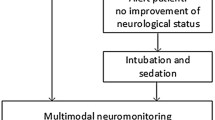Abstract
Objective
Magnesium sulfate is being investigated for the prevention or treatment of vasospasm following subarachnoid hemorrhage.
Patient
A 45-year-old woman suffered subarachnoid hemorrhage and developed after 8 days symptomatic vasospasm in the left middle cerebral artery (MCA) while she was receiving nimodipine prophylactically.
Methods and results
Transcranial Doppler monitoring was performed. Cerebral autoregulation was abolished in the left MCA. Despite this finding the administration of a bolus dose of MgSO4, followed by a continuous infusion in order to achieve serum magnesium levels in the range of 4–4.5 mg/dl (1.65–1.85 mmol/l), resulted in a marked decrease (12.2%) of the left MCA mean blood flow velocity, without clinically relevant change in systemic blood pressure (3%). This effect was maintained for at least 4 h. It did not prevent the development of ischemic lesions.



Similar content being viewed by others
References
Dorsch NW (2002) Therapeutic approaches to vasospasm in subarachnoid hemorrhage. Curr Opin Crit Care 8:128–133
Boet R, Mee E (2000) Magnesium sulfate in the management of patients with Fisher grade 3 subarachnoid hemorrhage: a pilot study. Neurosurgery 47:602–607
Veyna RS, Seyfried D, Burke DG, Zimmerman C, Mlynarek M, Nichols V, Marrocco A, Thomas AJ, Mitsias PD, Malik GM (2002) Magnesium sulfate therapy after aneurysmal subarachnoid hemorrhage. J Neurosurg 96:510–514
Chia RY, Hughes RS, Morgan MK (2002) Magnesium: a useful adjunct in the prevention of cerebral vasospasm following aneurysmal subarachnoid hemorrhage. J Clin Neurosci 9:279–281
Brewer RP, Parra A, Lynch J, Chilukuri V, Borel CO (2001) Cerebral blood flow velocity response to magnesium sulfate in patients after subarachnoid hemorrhage. J Neurosurg Anesthesiol 13:202–206
Pyne GJ, Cadoux-Hudson TAD, Clark JF (2001) Magnesium protection against in vitro cerebral vasospasm after subarachnoid hemorrhage. Br J Neurosurg 15:409–415
Giller GA (1991) A bedside test for cerebral autoregulation using transcranial Doppler ultrasound. Acta Neurochir (Wien) 108:7–14
Smielewski P, Czosnyka M, Kirkpatrick P, McEroy H, Rutkowska H, Pickard JD (1996) Assessment of cerebral autoregulation using carotid artery compression. Stroke 27:2197–2203
Dernbach PD, Little JR, Jones SC, Ebrahim Z (1988) Altered cerebral autoregulation and carbon dioxide reactivity after aneurysmal SAH. Neurosurgery 22:822–826
Feigin VL, Rinkel GJ, Algra A, Vermeulen M, van Gijn J (1998) Calcium antagonists in patients with aneurysmal subarachnoid hemorrhage: a systematic review. Neurology 50:876–883
Muir KW (2001) Magnesium for neuroprotection in ischaemic stroke: rationale for use and evidence of effectiveness. CNS Drugs 15:921–930
Fuchs-Buder T, Tramer MR, Tassonyi E (1997) Cerebrospinal fluid passage of intravenous magnesium sulfate in neurosurgical patients. J Neurosurg Anesthesiol 9:324–328
Ram Z, Sadeh M, Shacked I, Sahar A, Hadani M (1991) Magnesium sulfate reverses experimental delayed cerebral vasospasm after subarachnoid hemorrhage in rats. Stroke 22:922–927
van den Bergh WM, Zuur JK, Kamerling NA, van Asseldonk JT, Rinkel GJ, Tulleken CA, Nicolay K (2002) Role of magnesium in the reduction of ischemic depolarization and lesion volume after experimental subarachnoid hemorrhage. J Neurosurg 97:416–422
Lundvrook GL, James MF, Upton RN (1999) The effect of magnesium sulfate on cerebral blood flow velocity, cardiovascular variables, and arterial carbon dioxide tension in awake sheep. J Neurosurg Anesthesiol 11:96–101
Sadeh M (1989) Action of magnesium sulfate in the treatment of preeclampsia-eclampsia. Stroke 20:1273–1275
Author information
Authors and Affiliations
Corresponding author
Rights and permissions
About this article
Cite this article
Barile, M., van de Wyngaert, F., Mbia, JJ.E. et al. Intravenous magnesium sulfate administration in a patient with refractory vasospasm following subarachnoid hemorrhage. Intensive Care Med 29, 1182–1185 (2003). https://doi.org/10.1007/s00134-003-1752-9
Received:
Accepted:
Published:
Issue Date:
DOI: https://doi.org/10.1007/s00134-003-1752-9




